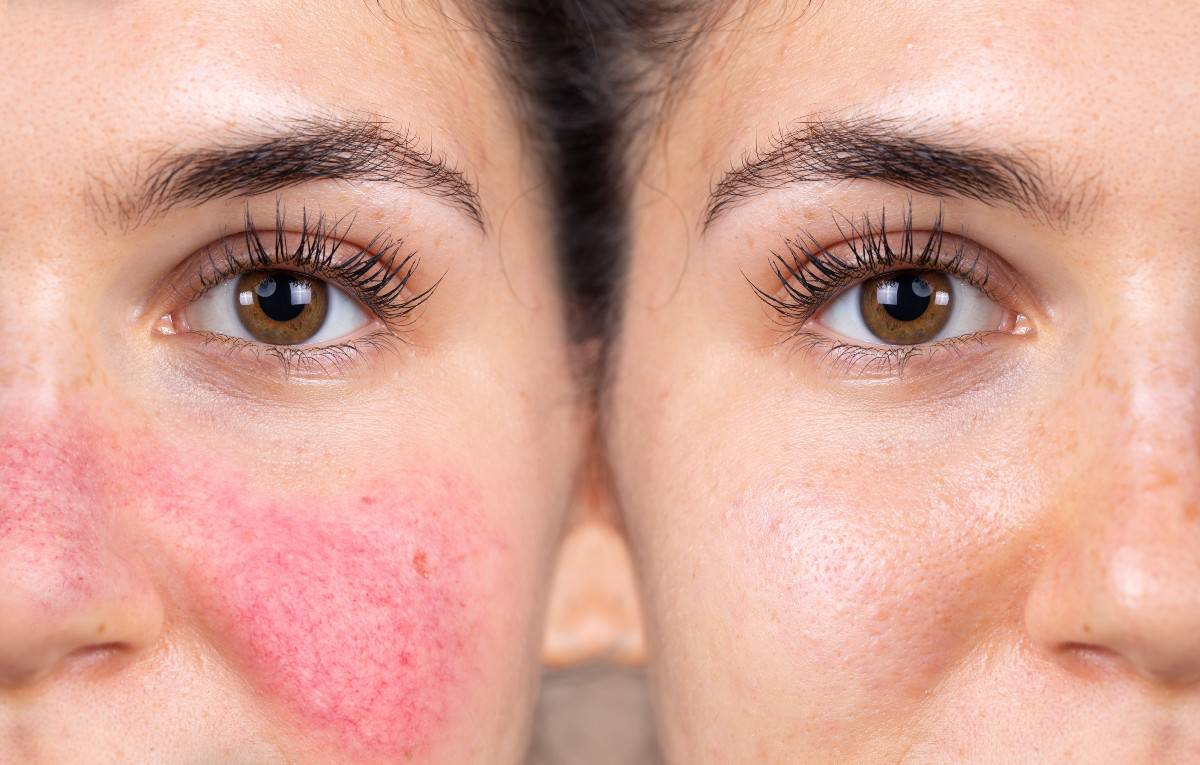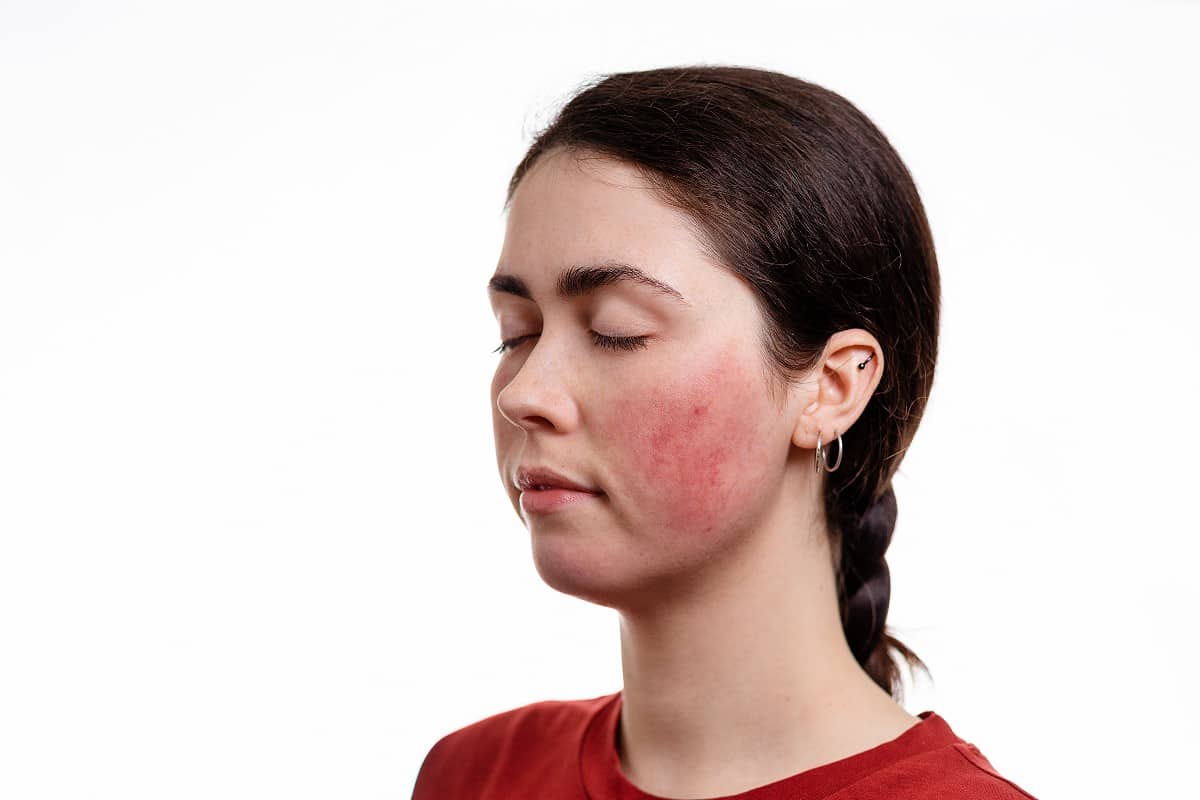Learn commonly overlooked root causes of rosacea, including poor gut health, histamines, and food sensitivities. Plus, learn how to overcome rosacea naturally!

Note from Dena: This guest post was co-written by Sarah Fennewald and Blair Cooley, Dietetic Interns, as part of a research partnership between Back To The Book Nutrition and post-graduate nutrition students from the University of Houston.
Most people associate rosacea with redness or acne on the face, but its sufferers know it’s much more than that. Rosacea affects 16 million Americans and is linked to poor gut health, allergies, asthma, hormone imbalance, dementia, anxiety, and depression. (1, 2, 3, 9, 10). The highest prevalence is seen among adults of Northern European heritage with fair skin.
Traditional dermatologists recommend topical creams, oral antibiotics, and medications to help manage skin related symptoms, but underlying causes of rosacea often aren’t addressed. Sadly, most individuals with rosacea are told this is something that they must live with forever.
Thankfully, that’s not necessarily true!
A holistic approach to rosacea can help sufferers identify and overcome the deeper root health issues, alleviating symptoms from the inside out, reducing risk for associated conditions, and dramatically improving quality of life.
Rosacea Subtypes and Symptoms
Let’s start with some background on Rosacea. Rosacea is a chronic inflammatory skin condition with 4 subtypes. An individual may have more than one subtype at the same time or it may evolve from one subtype to another over time.
Rosacea Subtypes
- Subtype 1 – Erythematotelangiectatic Rosacea: flushing, persistent redness, and visible blood vessels (“spider veins”). This is the most common.
- Subtype 2 – Papulopustular Rosacea (previously called acne rosacea): persistent redness, bumps and pimples that may come and go
- Subtype 3 – Phymatous Rosacea: skin thickening, enlargement of the nose
- Subtype 4 – Ocular Rosacea: effects the eyes including dry eye, tearing and burning, swollen eyelids, and potential loss of vision
In addition to the subtype-specific symptoms listed above, rosacea always includes at least one of the following primary symptoms. (3,4)
Most Common Rosacea Symptoms
These usually appear intermittently on the checks, chin, nose, or forehead.
- Flushing
- Persistent Redness
- Bumps and Pimples
- Visible Blood Vessels (“spider veins”)
- Flares worsen in certain environments (windy, hot, etc.)
What Really Causes Rosacea?
According to the traditional medical community, the exact cause of rosacea is unknown and there is no current cure for the condition. In contrast, functional medicine and holistic practitioners take the skin symptoms into account, but also use them as signals to uncover deeper issues going on beneath the surface.
As with most health conditions, there are multiple underlying factors in rosacea rather than just one cause. Here are some of the most common ones, according to the latest research.
Gut Imbalances
- SIBO: Nearly half of patients with rosacea also have Small Intestinal Bacterial Overgrowth (SIBO), and 90% of rosacea patients experience significant or complete resolution of their symptoms once their SIBO is treated. (7) Get tested for and overcome SIBO naturally with Holistic Nutrition Coaching!
- Low Stomach Acid (Hypochlorhydria): In recent years, more and more studies have showed that low stomach acid is involved in the occurrence and development of rosacea. H. Pylori, zinc deficiency and chronic stress can all lower your stomach acid levels, and treatment for these has shown significant results in the treatment and eradication of rosacea as well. (11,12)
- H. Pylori: H. Pylori is a stomach infection that reduces your stomach acid and is a histamine producer. Histamine triggers the immune response and increases the permeability of small blood vessels. Because of these effects, it is thought to make rosacea symptoms worse.
- Dysbiosis: When you have an imbalance of “good” and “bad” bacteria or yeasts in the gut, the environment of the gut is disrupted. When this happens, it can cause a plethora of unwanted symptoms throughout the body, including inflammation and rosacea.
- Leaky Gut: When gaps between cells in the intestinal wall are not as tight as they should be, it allows food proteins and other particles to seep through, triggering an immune response and inflammation. The official term is “enhanced intestinal permeability,” more commonly known as Leaky Gut. (13)
- Candida Overgrowth: Another overgrowth in the GI tract that can releases histamine, increases inflammation, and can trigger rosacea.
Inflammation
Rosacea is an inflammatory condition. And when the skin appears inflamed, it is often a sign that there is inflammation elsewhere in the body (6). It’s important to determine the source of the inflammation – whether stress, poor gut health, excess body fat, illness, autoimmunity, nutrient deficiencies, or a combination of these and other factors.
Impaired Nerve Function
Rosacea patients have higher levels of Substance P, a neurotransmitter and potent vasodilator produced in the gut, brain, and skin. Altered gut microbiota increase Substance P production in both the gut and the skin, which may explain why Substance P levels rise during a rosacea flare. Again, this points back to the role of gut health in rosacea. (5,8)
Histamines & Mast Cell Activity
Mast cells are the first line of cells in our immune system that interact with environmental allergens and antigens, and are involved in other immune-related conditions like asthma, eczema, and seasonal allergies. When they detect an allergen, mast cells release histamine, which expands the blood vessels and can make the surrounding skin itchy, red, and/or swollen. We now know rosacea patients have a higher levels of mast cells and therefore histamine (14).
Histamines come from 3 main sources:
- Mast cells make them in response to allergens or irritants
- Foods that naturally have histamines in them
- Gut bacteria and yeasts that produce histamine
When you have more histamine than your body is able to break down and remove, symptoms like red, itchy, or swollen skin, sneezing, watery eyes, diarrhea, rosacea, etc. can develop.
Skin Triggers
While the skin issues may not be a root cause of rosacea, certain environmental factors can exacerbate symptoms for already-damaged skin. Common triggers include:
- Alcohol
- Spicy of hot foods and drinks
- Exercise
- Sun and wind exposure
- Conventional make up and skin care products
Food Triggers
Fermented foods naturally contain a higher amount of histamine that can cause vasodilation responses, which allows blood to rush to our skin’s surface quickly. Some of the most common food triggers reported by rosacea patients are items like yogurt, cheese, sour cream, soy, yeast and chocolate (15).
Sensitivities to other foods and food additives can cause rosacea flares too, regardless of their histamine content. These vary from person to person and are usually linked to poor gut health.

How to Overcome Rosacea Naturally
1. Fix your gut
We’ve already established a clear link between rosacea and gut health, so it goes without saying that identifying and addressing SIBO, dysbiosis, low stomach acid, Leaky Gut, or other gut overgrowths, infections, or pathogens, is a top priority.
2. Reduce Inflammation
In addition to improving gut health, here are some excellent ways to reduce inflammation in the body:
- Manage stress – remember both negative and positive “stressors” can elicit a stress response from the body
- Improve sleep to maximize rest and repair functions, and soothe inflammation.
- Exercise…but not too much! Over exercising can actually increase inflammation rather than reduce it.
- Eat a colorful, plant-rich diet with plenty of anti-inflammatory omega-3 fatty acids from wild caught seafood and pastured raised meats.
- Minimize added sugars and processed foods, especially those with processed oils (canola, safflower, etc.)
- Laugh, play, and pray more!
3. Remove Skin Triggers & Food Sensitivities
If you have rosacea, it’s important to minimize exposure to your personal skin triggers. Triggers are different for each individual so keep a daily symptom diary to determine what yours are, then avoid those foods or activities.
Switching over to natural make up and skin care products is also a great idea. Download a list of all my favorite nontoxic skin care and household products here!
4. Correct Histamine Intolerance
Depending on which of the three main sources of histamines are contributing most to your symptoms, one or more of these could help:
- Limit high histamine foods – Alcohol, aged cheese, avocados, smoked meats/fish, fermented veggies, shellfish, tomatoes and spinach to name a few (here’s a list of high histamine foods to guide you)
- Take a DAO enzyme supplement before all meals – DAO is an enzyme our body makes to break down histamines so taking more of it before eating helps reduce extra histamines from your foods.
- Avoid environmental allergens/irritants that trigger your symptoms
- Consider natural antihistamine supplements like quercetin, nettles, bromelain, etc.
- Correct overgrowths of gut bacteria/yeast that produce histamine
- Support detox – especially organs that break down and remove histamines (lymph, liver, gallbladder, kidneys, and bowels)
5. Choose Topical Products Wisely
With rosacea, your skin may be more sensitive to conventional cleansers, toners, and acne products. Switch to simple, soothing products that nourish the skin like cleansing oils. Always test on an unaffected area of your skin before applying to your face. Work with a holistically minded dermatologist and/or esthetician knowledgeable in rosacea to guide you to the best topicals for you.
6. Approach Medications Cautiously
In traditional dermatology, medications (usually antibiotics) are a first line therapy for rosacea. I’m certainly not anti-medication, but it’s a good goal to save them for when they’re truly needed and will help the most. I’d urge you to ask some questions before taking medications.
- Will this medication address root causes or just help manage symptoms?
- How long will I need the medication?
- What are the side effects?
- What are the long term impacts of this medication on my gut and other areas of my health?
- Is there a gentler topical version I can try before a stronger oral one?
- Are there more natural alternatives to this medication?
- Are there diet and lifestyle measures I should try first?
The Bottom Line
If you really want to get your rosacea under control, you have to find and fix the deeper root cause(s) under the surface. It can be a process and skin symptoms sometimes get worse before they get better, but it can be done!
NOTE FROM DENA:
I’ve have helped a number of clients identify and overcome rosacea with comprehensive stool testing, natural supplements, and personalized diet and lifestyle recommendations, and I’d love to help you too! Schedule a free, 10 minute Discovery Call here to learn more!
Check out these related posts!
10 Ways to Overcome Acne Naturally
The Best Diet for SIBO & why diet alone won’t fix it

About the Co-authors:
Sarah Fennewald completed her B.S. in Dietetics at Fontbonne University in St. Louis, Missouri and co-wrote this post as a Dietetic Intern at the University of Houston. Sarah’s goal is to use her nutrition knowledge to empower individuals to make real life changes that will improve their quality of life.

Blair Cooley has a B.S. in Journalism and Business from the University of Missouri and completed her Post-Baccalaureate in Nutrition at the University of Houston. She is currently a Dietetic Intern who loves to cook and share her healthy, quick recipes with everyone, while having fun along the way!
Disclaimer: Information on this site is intended only for informational purposes and is not a substitute for medical advice. Always consult with a trusted healthcare provider before implementing significant dietary change. Read additional disclaimer info here.
References:

What is inc deficiency? Was it supposed to read zinc deficiency?
Yes, it should – thank you Tara! Just corrected that.
Can a biopsy of the face determine whether it is Rosacia? My doctor wants to do this and I want a second opinion.
I haven’t heard of skin biopsies confirming Rosacea but definitely something to ask your doctor more about. I’ve definitely heard of skin biopsies to rule out other diagnoses so your doctor can more confidently diagnose Rosacea.
This is a very helpful and informative post. Glad to know of the skin triggers part and your recommended solutions.
I am so grateful for this post. For me poor gut health and inflammation has resulted in this condition. I have tried so many dermatologists without much help.
I knew someone in high school who struggled with this. It’s so difficult sometimes.
It always amazes me how the environment and the things we eat affects the body. It’s all connected.
This is a really informative. Thank you.
wow..this disease is much new for me i haven’t heard of this before…Well am glad i haven’t ever suffered from any of skin disease..Thanks for such valuable info…
I had no idea what causes rosacea but it all makes sense. Our bodies are completely intertwined. When one thing fails, it causes others to fail.
Absolutely needed this. My skin type always have this type of redness and blemishes. This natural solution is epic.